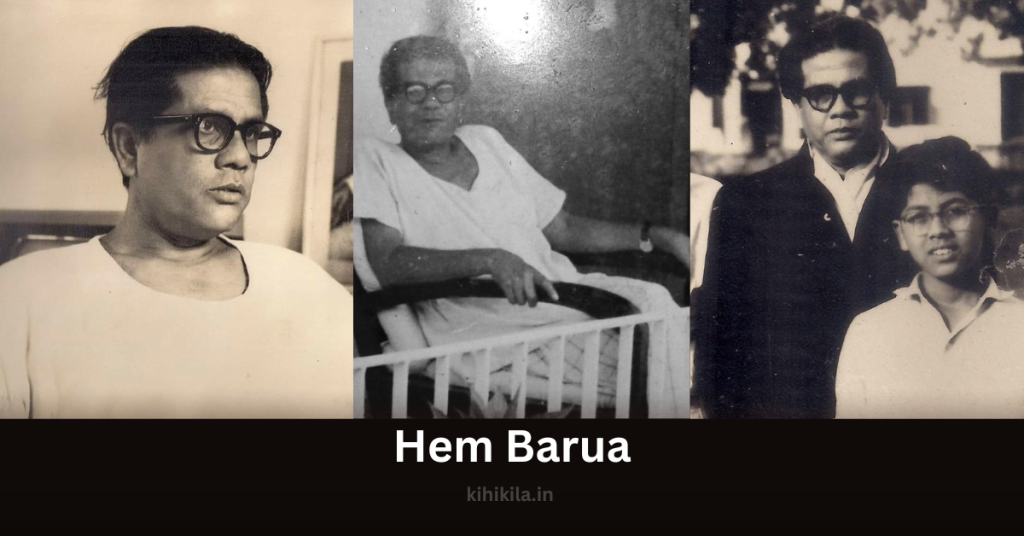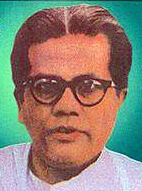Introduction:
Hem Barua was not just a poet but also a leader who played a significant role in shaping modern Assam. His contributions to literature and politics continue to inspire generations. Born on April 22, 1915, in Tezpur, Assam, he excelled in academics and later dedicated his life to literature and public service.
This article explores his journey, highlighting what makes him unique among Assamese poets and politicians.
Early Life and Education
Hem Barua was an outstanding student during his school and college years. His brilliance earned him a Master’s degree in English from Calcutta University in 1938. He then embarked on a teaching career, joining J.B. College, Jorhat, as an English lecturer in 1941. However, his passion for India’s freedom struggle led him to quit his job within a year.
Contribution to the Freedom Movement

In 1942, when the Quit India Movement gained momentum, Hem Barua actively participated. His involvement led to his imprisonment in 1943. After being released, he resumed his teaching career at B. Barua College, Guwahati, and eventually became its principal. His life reflected his deep commitment to both education and the nation’s freedom.
Literary Achievements: A Pioneer in Assamese Literature
Hem Barua is one of Assam’s most celebrated poets and authors. His writings beautifully capture the essence of Assamese culture, history, and emotions. His contribution to Assamese literature made him the President of Assam Sahitya Sabha in 1972.
Notable Works of Hem Barua:
Here are some of his remarkable literary works:
- Adhunik Sahitya (1948)
- Sagar Dekhicha (1954)
- Balichanda (1959)
- San Mihali (1958)
- Cupid Aru Psyche (1959)
- Ranga Karabir Phul (1959)
- Kannaki (1960)
- Ei Git (1961)
- Idle Hours (1962)
- Assamese Literature (1962)
- Sahitya Aru Sahitya (1962)
- Achuphul (1964)
- Man Mayuri (1965)
- Bahagate Pati Jaon Biya (1969)
- Smritir Papari (1970)
Among his most significant works, The Red River & the Blue Hill (1954) remains a classic. This book extensively covers the ethnic communities and tribes of Northeast India, making it an invaluable resource for anyone studying the region’s culture and history.
Political Career: A Voice for the People
While literature was his passion, politics was his duty. Hem Barua left the Congress Party in 1948 and joined the Socialist Party. He later became a key member of the Praja Socialist Party and was elected to the Lok Sabha multiple times.
Elections and Parliamentary Role:
- 1957: Elected as Lok Sabha MP from Guwahati
- 1962: Re-elected from Guwahati
- 1967: Elected from Mangaldoi
- Served till December 1970
Despite being in the Opposition, Hem Barua’s leadership and clarity of thought earned him respect from all political quarters. Even Prime Minister Jawaharlal Nehru frequently sought his opinions on key issues, often inviting him for informal discussions over breakfast.
A Strong Advocate for Assam
Hem Barua used his parliamentary platform to bring attention to Assam’s critical issues. He raised concerns about regional development, ethnic identities, and economic progress. His ability to voice the needs of Assam on a national stage distinguished him from other leaders of his time.
A Lasting Legacy
Hem Barua’s contribution to Assamese literature and politics remains unparalleled. His poetic expressions and political speeches carried the essence of Assamese culture, making him a beloved figure across the region. His leadership and vision continue to inspire young minds.
On April 9, 1977, Assam lost one of its most influential figures. However, his poetry, books, and the impact he made in politics ensure that his legacy lives on.
Conclusion
Hem Barua was more than just a poet or a politician—he was a guiding force for Assam. His words and actions were dedicated to the people, and his legacy will forever remain a part of Assamese history.
Would you like to explore more about Assamese Literature and politics? Stay tuned for more insightful articles!
FAQ’s:
Q 1. Who was Hem Barua, and why is he famous?
Hem Barua was a renowned Assamese poet, writer, and politician known for his literary contributions and role in Indian politics.
Q 2. What are some of Hem Barua’s most famous literary works?
His notable works include Adhunik Sahitya, Sagar Dekhicha, Balichanda, Kannaki, The Red River & the Blue Hill, and Assamese Literature.
Q 3. What was Hem Barua’s role in Indian politics?
He was a Member of Parliament from Assam, elected to the Lok Sabha multiple times between 1957 and 1970, and was associated with the Praja Socialist Party.
Q 4. When and where was Hem Barua born?
Hem Barua was born on April 22, 1915, in Tezpur, Assam.
Q 5. What was Hem Barua’s educational background?
He was a brilliant student and obtained his Master’s degree in English from Calcutta University in 1938.
Q 6. How was Hem Barua involved in India’s freedom struggle?
He participated in the Quit India Movement and was imprisoned in 1943 for his involvement in the freedom struggle.
Q 7. Why did Hem Barua leave Congress and join the Socialist Party?
He left Congress in 1948 to join the Socialist Party, later becoming a key leader in the Praja Socialist Party.
Q 8. What was Hem Barua’s contribution to Assamese literature?
He was a pioneer of modern Assamese literary movements, writing poetry, essays, and books that enriched Assamese culture and literature.
Q 9. What is Hem Barua’s most significant English work?
His book The Red River & the Blue Hill (1954) is one of his most important works, covering the ethnic communities and tribes of Northeast India.
Q 10. When did Hem Barua pass away, and what is his legacy?
He passed away on April 9, 1977, but his literary and political contributions continue to inspire generations in Assam and beyond.












